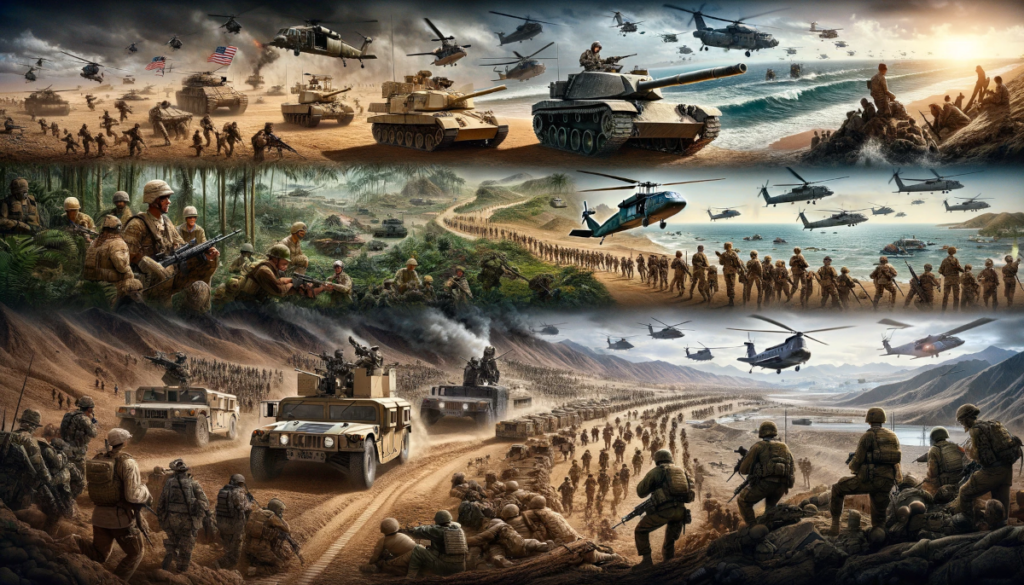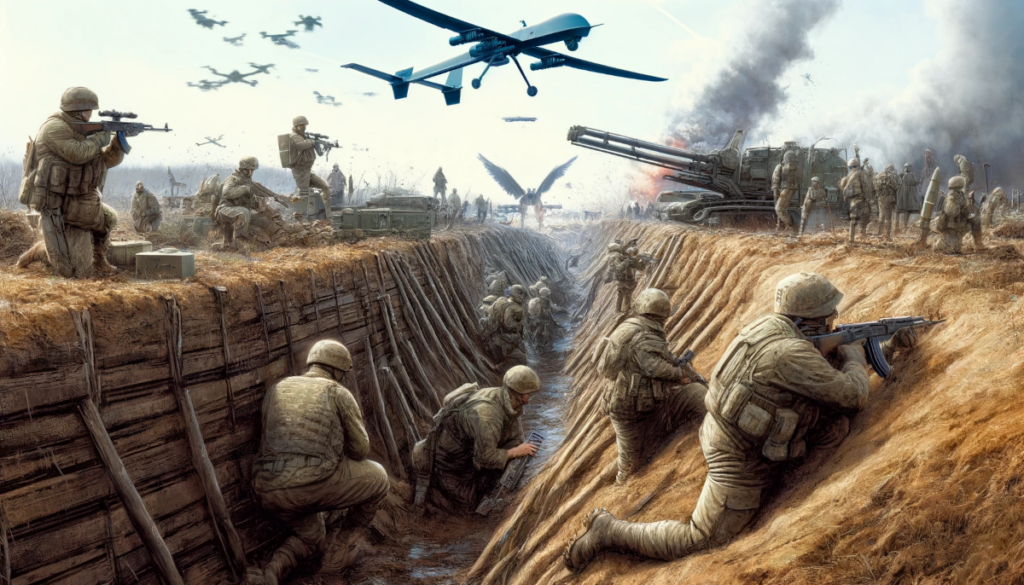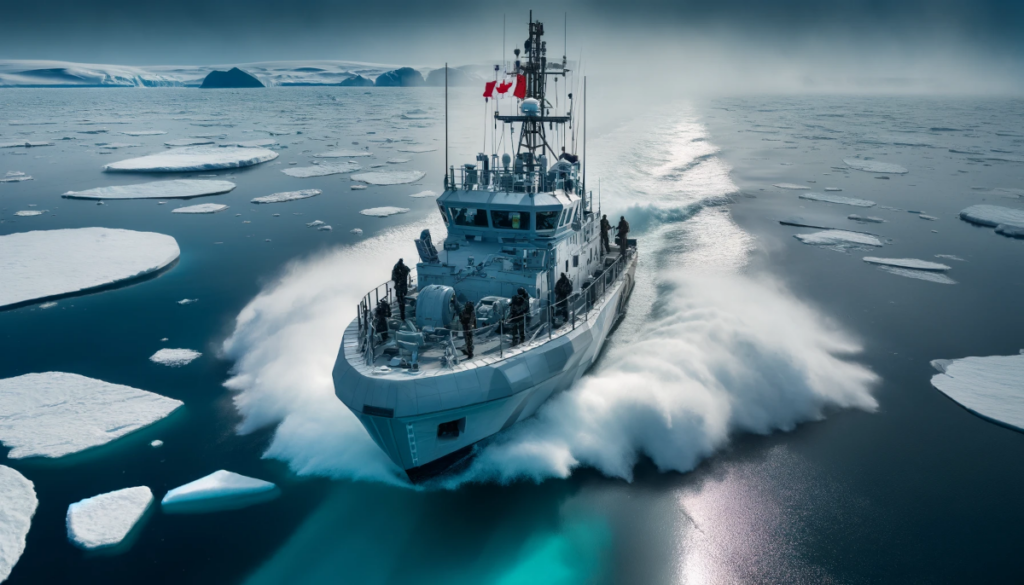
A collage showcasing key military engagements of the U.S. since 1945, including images from the Gulf War, Vietnam War, Afghanistan War (DALL-E)
(Written by C. L. and D.B. Hay.)
The current global geopolitical landscape is witnessing a challenge to American hegemony rarely seen before (with the ultimately empty exception of the USSR) by countries like Russia, Iran, China, and North Korea.
At the end of World War II, no nation equalled the economic, political, and military power of the USA. It had the strongest army, air force and navy in the world. It led the way in forming many international alliances and organizations including the United Nations and NATO, the latter designed as a European focused defensive counter-weight designed to ‘contain’ the USSR.
In evaluating post-1945 conflicts, it’s essential to consider the nuanced nature of military engagements and recognize that clear-cut victories, like the Gulf War, contrast with more ambiguous outcomes, such as in Korea and the protracted conflicts in Vietnam and Afghanistan. Each instance contributes to a complex narrative of military interventions in the latter half of the 20th century and beyond.
Since 1945, the United States has a global perspective and presence on security matters; it has had the ability to project immense power across the world, at all times. The United Kingdom tended to enjoy a similar status in the decades before the First World War.
Times keep changing. While the U.S. military remains formidable, challenges have arisen during the transition from warfare to nation-building exercises, as seen in post-invasion scenarios in Iraq and Afghanistan. The traditional one-size-fits-all ‘build a democracy’ approach to post-war reconstruction as in Germany and Japan has proven ineffective in more culturally diverse regions. Notable conflicts since 1945, such as the Vietnam War and the Global Wars on Terror in Afghanistan and Iraq, have shaped both perceptions and the reality of American military strategy and pre-eminence.
A key turning point in the decline of America’s position globally may well have been President Obama’s decision not to respond militarily to Bashar al-Assad’s use of chemical weapons in Syria. The subsequent chaotic withdrawal from Afghanistan under the Biden administration marked a symbolic end to the current era of American hegemony, emboldening adversaries. Russia and Iran stepped further into the power vacuum in the Middle East, challenging the established order. China began exercising greater pressure especially on Taiwan, as well as the Philippines and other Pacific countries.
The emergence of a new axis, supported by Russia and Iran, China and North Korea is disrupting international trade and challenging the post-1945 ‘rules-based order’. This shift poses threats in regions like the Arctic, West Africa, the Middle East, and the South China Sea even South America. While the U.S. had small military successes with interventions in Panama and Grenada, challenges arose in sustaining occupations, as seen in Iraq and Afghanistan. The complexity of multi-facetted nation-building and insurgencies, coupled with domestic opposition to prolonged overseas conflicts, contributed to perceived failures.
Massive growth in US Government debt coupled with increasing civil and political discord within the United States, has caused not a few media commentators and political leaders to question its leadership capabilities. Underperformance of American (and other NATO) military equipment in Ukraine plus inadequate ammunition production, have caused some to question the real strength of American and other NATO military capability.
Until the Russo-Ukraine War, given the diverse nature of other occurring conflicts, a shift is observable towards hybrid warfare, where terrorist groups funded by the Iran-backed Axis of Resistance adopt strategies blending conventional military and insurgent tactics. Non-state groups like ISIS, the Houthis, Hamas, and Hezbollah, operate as de facto governments and military forces without recognized land boundaries. This evolving landscape underscores the unique challenges posed by the diverse nature of contemporary warfare.
Again, until the Russo-Ukraine War, it might be said that NATO was gradually slipping into fractured irrelevance. Even as its membership grew, many members, including Canada, were not paying their agreed share. The Russo-Ukraine War has reverted more to the classic tactics of earlier major wars. Trench warfare and artillery (which now has increased range) have resumed their core roles abetted by drones and missiles.

A detailed illustration of trench warfare with modern updates, showing soldiers in trenches, supported by drones and advanced artillery (DALL-E)
So, what then are the implications for Canada if the Russo-Ukraine War expands into a Russia-NATO conflict? Will it start as a ‘conventional non-nuclear war’? Will Canada be expected to stand up for European NATO members? Can Canada stand up for itself? (These questions lose relevancy in a nuclear conflict not considered herein.)
Canada does not have nor has ever had that capability (except for the War of 1812) although it had an immense military size at the end of WW2. The Canadian Navy was the fourth largest in the world at the cessation of hostilities. Today, we do not meet our NATO spending requirements and practically every assessment coming out of the military or intelligence services says that we are woefully unprepared. Canada’s tank fleet is in complete disrepair as of 2018; an estimation suggested only 15% of the Leopard 2 tanks were operable. Canada has promised the sum-total of eight Leopard 2 tanks to Ukraine, but it is unclear how many have been fielded in Ukraine. (Nor is it clear that the Government has moved on its commitment to replace the eight with new tanks, which may be a good thing given the diminished survivability of tanks in new era of ‘drone warfare’ strategies.)
A considerable number of retired Canadian military leaders have called for major upgrades and replenishment of Canadian military equipment. Recall the debate about the state of the once proud Canadian Air Force, where instead of committing to the previously agreed acquisition of F35’s, used Australian Super Hornets were purchased to replace the ‘out of date’ CF18s. Having lost its place in the F35 production queue, Canada may get F35s in the 2030’s.
Turning to the Royal Canadian Navy, Canada’s 4 boat submarine fleet (acquired years ago from Great Britain) spends more time tied up to their docks than patrolling our coasts according to Navy personnel. Canada is a country with three sea borders, yet has only 2, soon to be 4 (of a total of 8) ice reinforced Harry DeWolf class small coastal patrol vessels which according to media reports have a ‘flooding problem’ (National Post, March 7, 2024); plus one Coast Guard ice breaker, capable of patrolling the three borders or even supporting drone patrols thereof. The icebreaking capability of our navy and an increase in our overall military and economic presence in the Arctic seems more than appropriate as the Northwest Passage ‘opens’ more to navigation.

A modern Canadian Arctic patrol boat navigating icy waters (DALL-E)
There is of course more to a country’s military: strategy, tactics and above all, adequate numbers of trained personnel. In the last few months Canadian media have featured stories about the ‘shortfall’ in recruitment, hence total personnel, for all sectors of the Canadian military. There is considerable speculation about the reasons for such a shortfall: negative perceptions of military lifestyle and discipline; other job and career opportunities; preference for non-arduous work. There has been another change notable over the past several decades. Historically, Canada has been as a ‘nation’, in the European sense, composed of gradual immigration principally from European nations in the 1800’s and most of the decades of 1900’s. In more recent years, Canada has benefitted from immigration from a broader range of countries, many with more diverse cultural histories than earlier immigrants to Canada leading to a nation with less shared history and values. As well, the greater urbanization of Canadian society may have potentially affected the lifestyle expectations and desires of Canadian youth. At the same time, the phenomenal growth of rapid, reliable global communications has greatly diversified the range of information available of Canadian youth compared to their forebearers. Thus, such considerations may have also altered the perceptions of military-aged Canadians towards such concepts of ‘national identity’ or ‘national service’ or even ‘nationalism’ itself, often considered critical elements or motivators of military enrollment.
Coincidentally, the perceived reduction of American strength globally places more pressure on the other individual countries comprising NATO like Canada to increase their readiness and deterrence. As a matter of principal why should we let others do what we can do ourselves, such as adequately fund our military. Sure, the United States and our NATO allies are obligated to defend us if we are attacked, but should we not have our own capability to do so? Furthermore, outsourcing our security and military hardware thus means that we outsource our military decision making, albeit to allies who will prioritize their own self-interest.
No one cares more about Canada than Canadians, except those perhaps who might want its resources and territorial space. (One might ask: what countries nearby need/want more hard resources, more fresh water, more space and seek arctic experience.) Additionally, as the world order shifts towards a multi-polar arena the chance of conflict between Great Powers (China, Russia, U.S./NATO/Western Allies) increases. Canada must be able to secure its own vast borders and then still have the capability to project power and assist allies elsewhere, as should every other member of NATO if this defense-alliance is to withstand any and all military incursions. In the case of a multipronged invasion, each individual nation within the alliance will consider its own security before addressing the needs of an ally. Using Ukraine’s readiness for a full-scale invasion as a comparison, Canada can’t expect to last even a few weeks in a modern war against Russia or China.
Democratic Peace Theory suggests that democracies are less likely to go to war with each other. The core idea is that democratic states, those with representative governments elected by the people, tend to avoid conflict with other democracies since populations generally dislike war and want to live as best as they can. Therefore, when democracies do indeed go to war it is likely in self-defence (or against a non-democratic state and the end goal is usually turn your autocratic enemy into a democracy with which the West can negotiate and trade, a non-authoritarian civil order if you will.) When a non-democratic state goes to war, it is to conquer and take over. Underprepared democratic states are vulnerable even with NATO-like allies.
Sources:
Chollett, Derek. “Obama’s Red Line, Revisited – Politico Magazine.” Politico, 19 July 2016, www.politico.com/magazine/story/2016/07/obama-syria-foreign-policy-red-line-revisited-214059/.
Zivo, Adam. How Canada Sabotaged Its Own Fleet of Tanks | National Post, 25 Jan. 2023. nationalpost.com/opinion/adam-zivo-how-canada-sabotaged-its-own-fleet-of-tanks.
Royal Canadian Navy. Encyclopædia Britannica, 11 Jan. 2024, www.britannica.com/topic/Royal-Canadian-Navy.








